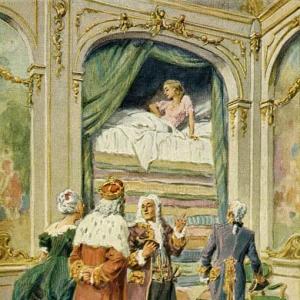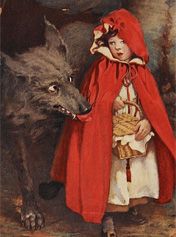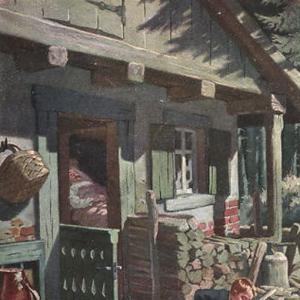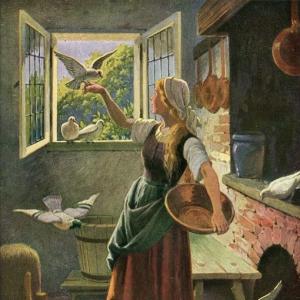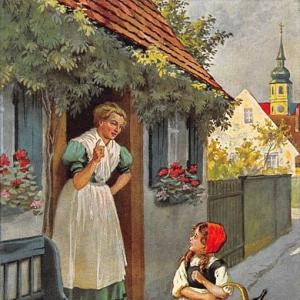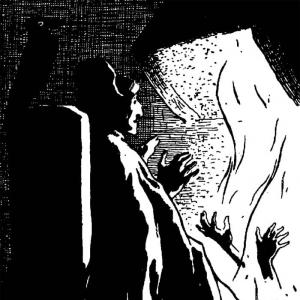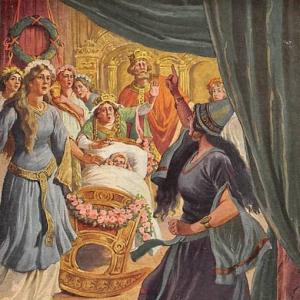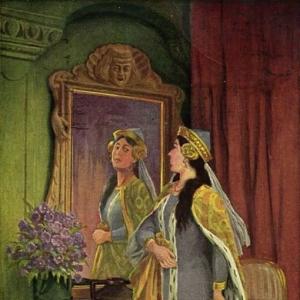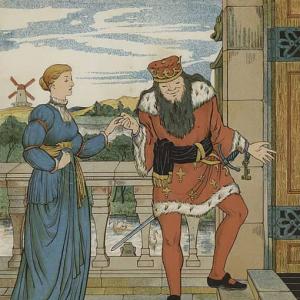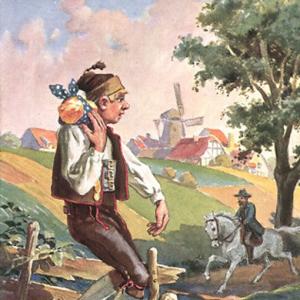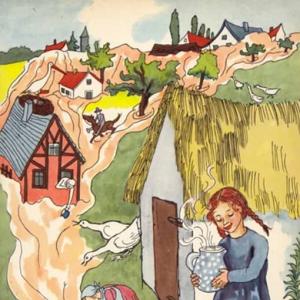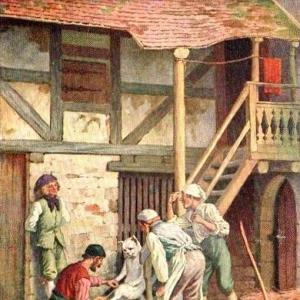Reading time: 3 min
The fox once came to a meadow in which was a flock of fine fat geese, on which he smiled and said, „I come in the nick of time, you are sitting together quite beautifully, so that I can eat you up one after the other.“ The geese cackled with terror, sprang up, and began to wail and beg piteously for their lives. But the fox would listen to nothing, and said, „There is no mercy to be had! You must die.“ At length one of them took heart and said, „If we poor geese are to yield up our vigorous young lives, show us the only possible favour and allow us one more prayer, that we may not die in our sins, and then we will place ourselves in a row, so that you can always pick yourself out the fattest.“ – „Yes,“ said the fox, „that is reasonable, and a pious request. Pray away, I will wait till you are done.“ Then the first began a good long prayer, for ever saying, „Ga! Ga!“ and as she would make no end, the second did not wait until her turn came, but began also, „Ga! Ga!“ The third and fourth followed her, and soon they were all cackling together.
When they have done praying, the story shall be continued further, but at present they are still praying without stopping.“
 Learn languages. Double-tap on a word.Learn languages in context with Childstories.org and Deepl.com.
Learn languages. Double-tap on a word.Learn languages in context with Childstories.org and Deepl.com.Backgrounds
Interpretations
Adaptions
Summary
Linguistics
„The Fox and the Geese“ is a traditional German fairy tale collected by the Brothers Grimm, Jacob and Wilhelm, in the 19th century. The Brothers Grimm were German academics, linguists, and folklorists who gathered and published numerous European fairy tales and folklore. Their collection, „Grimm’s Fairy Tales“ (originally titled „Children’s and Household Tales“), comprises over 200 stories, many of which have become world-renowned classics. Some other popular tales from their collection include „Cinderella,“ „Rapunzel,“ „Snow White,“ and „Hansel and Gretel.“
The Brothers Grimm aimed to preserve the cultural heritage and oral traditions of German and European folklore, which were primarily passed down through generations by word of mouth. The tales they collected often included elements of fantasy, magic, and morality lessons that served as educational tools for children and adults alike.
„The Fox and the Geese“ is a lesser-known tale from the Grimm’s collection, but it shares similar themes and characteristics with other stories in the anthology, such as cleverness, resourcefulness, unity, and the consequences of greed and overconfidence. Like many other Grimm’s tales, this story also uses anthropomorphism, attributing human characteristics to animals, to create a narrative that conveys moral lessons to its audience.
„The Fox and the Geese“ offers various interpretations that can be drawn from the story. Here are three possible perspectives:
The Power of Unity: The tale demonstrates the strength of unity and working together as a group. Faced with a life-threatening situation, the geese come together in prayer, delaying their demise. By acting as one, they stand a better chance of outsmarting the cunning fox.
Cleverness and Resourcefulness in the Face of Danger: The geese are initially portrayed as helpless and frightened, but they exhibit resourcefulness by asking for the chance to pray before their impending doom. In doing so, they buy time and potentially outwit the fox. This aspect of the story highlights the importance of using wit and intelligence to navigate challenging circumstances.
The Dangers of Overconfidence and Greed: The fox’s overconfidence and greed may be his downfall in this tale. He sees the geese as an easy meal and underestimates their ability to strategize. As he waits for their prayers to finish, he loses the upper hand in the situation, illustrating that overconfidence and greed can lead to one’s downfall.
These interpretations serve as moral lessons for the reader, emphasizing the significance of unity, resourcefulness, and the pitfalls of overconfidence and greed.
„The Fox and the Geese“ is a classic fairy tale that has been adapted in various ways throughout the years. Here are a few notable adaptations:
Animated films: The tale has been adapted into several animated films, including the Disney short „The Fox Hunt“ (1931), the Warner Bros. short „Foxy by Proxy“ (1952), and the Soviet animated film „The Fox and the Geese“ (1965).
Children’s books: The story has been adapted into numerous children’s books, including „The Fox and the Geese“ by Barbara Gregorich, „The Fox and the Geese: A Tale of the Curious Winter“ by Ellen Stoll Walsh, and „The Fox and the Geese and the Wonderful Egg“ by Marianna Mayer.
Stage productions: The tale has been adapted into stage productions, including the children’s play „The Fox and the Geese“ by Robert M. Kelly and the puppet show „The Fox and the Geese“ by Martin Stevens.
Variations and parodies: The story has been parodied and adapted in various ways, including the Looney Tunes cartoon „Fast Feud“ (1962) which features Wile E. Coyote and Road Runner in the roles of the fox and geese, and the modern children’s book „The Wolf, the Duck, and the Mouse“ by Mac Barnett and Jon Klassen, which puts a twist on the tale by having the mouse and duck team up to outsmart a wolf.
Overall, „The Fox and the Geese“ has proven to be a versatile and enduring tale that continues to inspire new adaptations and interpretations.
„The Fox and the Geese“ is a fairy tale by the Brothers Grimm, which tells the story of a cunning fox who chances upon a flock of plump, unsuspecting geese in a meadow. Delighted by the opportunity, the fox announces his intention to eat them one by one. The terrified geese plead for their lives, but the fox is unmoved, insisting that they must die.
Finally, one brave goose proposes a final request before they meet their fate. The geese ask the fox to grant them one more prayer, so they may not die with unabsolved sins. They also promise to line up afterward, allowing the fox to easily choose the fattest among them. The fox agrees to their request, seeing it as a reasonable and pious act.
The first goose then initiates a long prayer, repeating the sound „Ga! Ga!“ over and over. Instead of waiting for her to finish, the second goose joins in, followed by the third and fourth, until all the geese are praying in unison. The story leaves off with the geese still praying continuously, delaying the fox’s plans and potentially outsmarting him.
The Brothers Grimm’s fairy tale „The Fox and the Geese“ presents an engaging narrative that offers rich material for linguistic analysis.
Dialogue and Direct Speech: The story heavily relies on dialogue, particularly between the fox and the geese. This use of direct speech adds immediacy and allows characters to express their personalities and intentions. The fox’s speech is direct, authoritative, and reflects his predatory nature. On the other hand, the geese’s speech is filled with supplication and fear, revealing their vulnerability.
Use of Irony: There is a layer of irony in the fox’s interactions with the geese. The fox acknowledges the „pious request“ of the geese to pray before their demise, which juxtaposes his predatory nature with the pretense of civility and reasonableness. This irony enhances the moral undertone of the tale.
Repetition and Onomatopoeia: The geese’s prayer, represented by „Ga! Ga!“, uses repetition, which serves as both a linguistic and narrative device. Linguistically, it highlights the simplicity and uniformity of the geese’s communication. Narratively, the repetition emphasizes the endless nature of their supposed prayer, which cleverly stalls their doom.
Narrative Structure: The story is structured around the clever maneuvering of the geese to delay their fate. The open-ended conclusion, „When they have done praying, the story shall be continued further, but at present they are still praying without stopping,“ leaves the resolution up to the imagination, a common feature in orally developed tales adapted to written form. This structure encourages active participation from the audience, who are left to ponder the eventual outcome.
Anthropomorphism: The tale anthropomorphizes animals, a common feature in fables and fairy tales, which allows for the exploration of human-like interactions and moral lessons through non-human characters. The fox’s cunning nature and the geese’s collective strategy directly mirror human traits and social behaviors.
Moral and Didactic Elements: Linguistically, the story serves as a didactic tale, potentially teaching about the value of cleverness and unity in the face of adversity. The geese’s eventual strategy of outsmarting the fox through their continuous „prayer“ provides a moral insight into the power of wit over brute force.
Overall, the linguistic elements of „The Fox and the Geese“ contribute significantly to its enduring appeal and effectiveness as a fairy tale, using dialogue, irony, and narrative techniques to convey moral lessons and entertain.
Information for scientific analysis
Fairy tale statistics | Value |
|---|---|
| Number | KHM 86 |
| Aarne-Thompson-Uther-Index | ATU Typ 227 |
| Translations | DE, EN, DA, ES, FR, PT, IT, JA, NL, PL, RO, RU, TR, VI, ZH |
| Readability Index by Björnsson | 27.7 |
| Flesch-Reading-Ease Index | 83.3 |
| Flesch–Kincaid Grade-Level | 6 |
| Gunning Fog Index | 8.6 |
| Coleman–Liau Index | 7.3 |
| SMOG Index | 8 |
| Automated Readability Index | 5.8 |
| Character Count | 1.189 |
| Letter Count | 897 |
| Sentence Count | 13 |
| Word Count | 229 |
| Average Words per Sentence | 17,62 |
| Words with more than 6 letters | 23 |
| Percentage of long words | 10% |
| Number of Syllables | 286 |
| Average Syllables per Word | 1,25 |
| Words with three Syllables | 9 |
| Percentage Words with three Syllables | 3.9% |

 Facebook
Facebook  Whatsapp
Whatsapp  Messenger
Messenger  Telegram
Telegram Reddit
Reddit